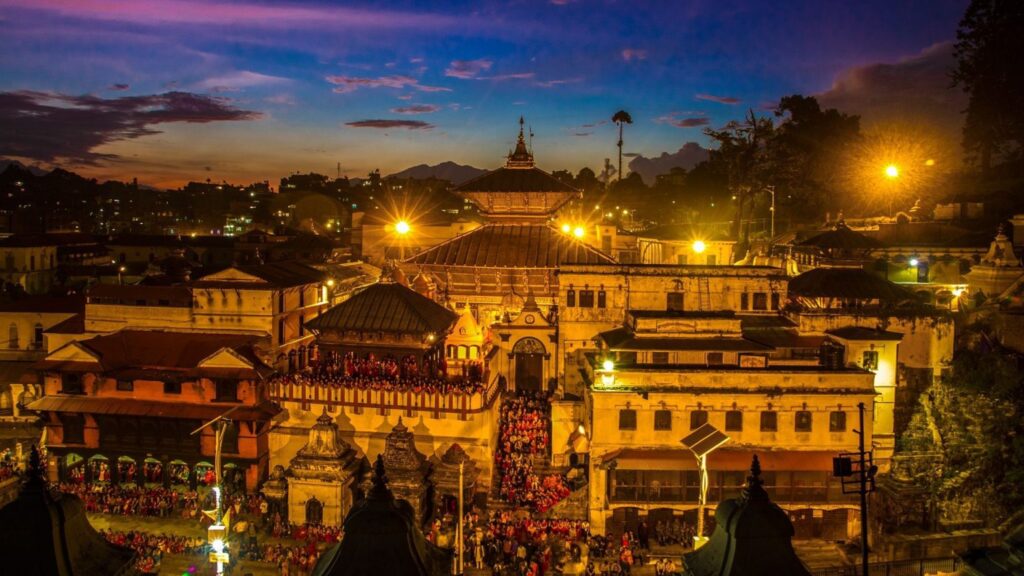History of Pashupatinath Temple

Pashupatinath Temple, one of the holiest Hindu temples, is situated in Kathmandu, Nepal, on the banks of the Bagmati River. It is dedicated to Lord Shiva, known as Pashupatinath, the lord of all living beings. This iconic temple, revered for centuries, offers a profound insight into Hindu spirituality, architectural grandeur, and cultural traditions.
The Truth About Pashupatinath Temple
Pashupatinath Temple is more than just a holy place; it’s a piece of Nepalese history. It’s thought to have been built around the 4th century CE, though some believe it might be even older. In the 12th century, King Bhupatindra Malla made major changes to the temple, giving it much of the style and look it has today.
The Pashupatinath Temple features beautiful wooden carvings, gilded roofs, and a pagoda-style design, showcasing Nepal’s rich cultural heritage. As a UNESCO World Heritage Site, it holds great historical and architectural value. The temple grounds include several shrines, ashrams, and ghats, which have been important for Hindu worship and rituals for centuries.
Myth about Pashupatinath Temple
Numerous myths and legends surround the Pashupatinath Temple, adding to its mystical allure. According to Hindu mythology, the temple is linked to the divine legend of Lord Shiva, who is believed to have appeared in the form of a sacred linga at this very site. One prevalent myth is that of the self-manifested linga, which is believed to have emerged spontaneously from the ground.
Another legend tells of how the temple’s site was chosen by Lord Shiva himself. It is said that Shiva, in disguise, once roamed the earth and came upon the Bagmati River, where he decided to settle. In this myth, the sacredness of the river and the temple is attributed to Shiva’s divine choice.
The temple’s role as a center of divine presence and spiritual power is reinforced by these myths, making it a focal point for Hindu devotees. Pilgrims believe that visiting the temple and performing rituals here can bring about spiritual liberation and blessings.
Pashupatinath Shiva Linga
At the heart of Pashupatinath Temple is the Shiva linga, a sacred symbol of Lord Shiva. The Shiva linga at Pashupatinath is considered one of the most revered in Hinduism. It is a cylindrical, abstract representation of Shiva, often symbolizing his formless, infinite nature.
The linga is enshrined in a silver-plated structure, and its worship is central to the temple’s rituals. Devotees believe that the Shiva linga here embodies the divine presence of Shiva, making it a powerful focal point for worship and meditation. The linga is adorned with various offerings and is bathed with sacred substances like milk, honey, and water during daily rituals.
The Shiva linga at Pashupatinath is not only a religious symbol but also a testament to the temple’s historical significance. It is believed that the linga has been venerated since ancient times, reflecting the deep-rooted traditions of Hindu worship at this site.
### Hindu Funeral Rites Performed at Pashupatinath
Pashupatinath Temple is well-known for Hindu funeral rites. The temple has several ghats, or steps leading to the Bagmati River, where cremations are held. Many Hindus believe that being cremated here helps secure a place in heaven and escape the cycle of rebirth.
The Arya Ghat is the most famous ghat at Pashupatinath Temple, where many important people are cremated. The ceremonies here are an important part of Hindu tradition, focusing on the soul’s journey from life to the afterlife.
The ceremonies are conducted with great reverence and follow strict rituals. Family members and priests perform the rites, which include the offering of prayers, chanting of sacred hymns, and the lighting of the funeral pyre. The river’s holy waters are used to cleanse and purify, further enhancing the sanctity of the ritual.
Why to Visit Pashupatinath?
Pashupatinath Temple is a must-visit destination for several reasons. First and foremost, it is a site of immense spiritual significance. For Hindus, visiting Pashupatinath is a profound experience, offering a chance to connect with their faith and participate in sacred rituals. The temple’s rich history and the divine presence of Lord Shiva make it a powerful place for meditation and reflection.
Moreover, the architectural beauty of the temple complex is a major attraction. The intricate carvings, gilded roofs, and traditional pagoda-style design provide a glimpse into Nepalese artistry and craftsmanship. The temple’s location by the Bagmati River adds to its serene and picturesque setting.
Visitors are also drawn to the vibrant atmosphere of the temple during festivals and rituals. Events like Maha Shivaratri and Teej attract large crowds, creating a lively and festive environment. Witnessing the evening aarti (ritual worship) and participating in temple activities offer unique cultural and spiritual experiences.
If you’re interested in visiting more meaningful and beautiful places, Lakshadweep is a great choice. To get the most out of this stunning beach destination, take a look at [Beach Bliss: 10 Essential Tips for Experiencing Lakshadweep’s Beauty in Summer Vacation](https://traveltofitness.com/beach-bliss-10-essential-tips-for-experience-lakshadweeps-beauty-in-summer-vacation/).
How to Visit Pashupatinath?
Visiting Pashupatinath Temple is relatively straightforward, with several options available depending on your starting point.
1. Location and Access: The temple is located about 5 kilometers from Kathmandu’s city center. It is easily accessible by taxi, rickshaw, or local bus. The roads are well-connected, and the journey from the city center typically takes around 15-20 minutes.
2. Entry Requirements: To enter the main temple area, you need to purchase an entry ticket. Foreign visitors are required to pay a nominal fee, while Nepali citizens can enter free of charge. Note that non-Hindus are not allowed inside the main temple’s inner sanctum but can explore the surrounding areas and witness the rituals from designated viewpoints.
3. Dress Code: Visitors are expected to dress modestly. It is advisable to wear clothing that covers the shoulders and knees. This respectful dress code aligns with the temple’s spiritual atmosphere.
4. In short, Pashupatinath Temple is a unique site with great historical and spiritual importance. It offers a deep connection to Hindu traditions and Nepalese culture through its rich history, sacred Shiva linga, and traditional rituals. Whether you want spiritual insight, cultural experiences, or to admire ancient architecture, visiting Pashupatinath Temple is a meaningful experience.
5. Local Guidance: It is often helpful to hire a local guide who can provide insights into the temple’s history, rituals, and significance. Guides can enhance your experience by offering detailed explanations and helping you navigate the temple complex.
In summary, Pashupatinath Temple is a special place with deep historical and spiritual value. It connects visitors to Hindu traditions and Nepalese culture through its rich history, sacred Shiva linga, and traditional rituals. Whether you’re looking for spiritual insight, cultural experiences, or admiration of ancient architecture, visiting Pashupatinath Temple offers a truly meaningful experience.










